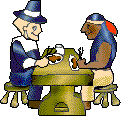 Native American
Native American

Herbs & Plants
Of The Southwest

Beans

Beans are one of the traditional “Three Sisters” triad
that were planted together, grew in a state of happy mutual benefit together,
and were the mainstays of the Native American diet. The protein food sources of
the Old World was greatly improved when Native American beans were introduced,
and Europeans eagerly adopted kidney beans, string beans, snap beans, butter
beans, lima beans, navy beans, pole beans, etc.
The descriptive term “common bean” includes all the dry
field varieties such as navy, kidney, pinto, northern, marrow and so on, plus
all the edible pod types of beans, such as green, snap and stringless. The
ancestor of these beans is believed to have originated in Central America long
before the arrival of Columbus and distributed along prehistoric trade routes,
as many different varieties of beans were cultivated by that time.
Today, the dry field varieties of beans are
a very important source of protein, for vegetarians, those wishing to cut down
on cholesterol intake, and in countries where meat consumption is not as
possible as in America. But it is very important to remember, for proper nutrition, that the protein of beans must be combined with other protein foods,
such as cheese, in order to have a full complement of all the amino acids
necessary.
The ancient symbol of the curled sprouting
bean, the “Nakwach”, is found throughout the Southwest in Ancestral Puebloan
rock art, and symbolizes life and rebirth. Many of our children first learn
about the wonder of plant growth by planting a bean in soil and a paper cup.


